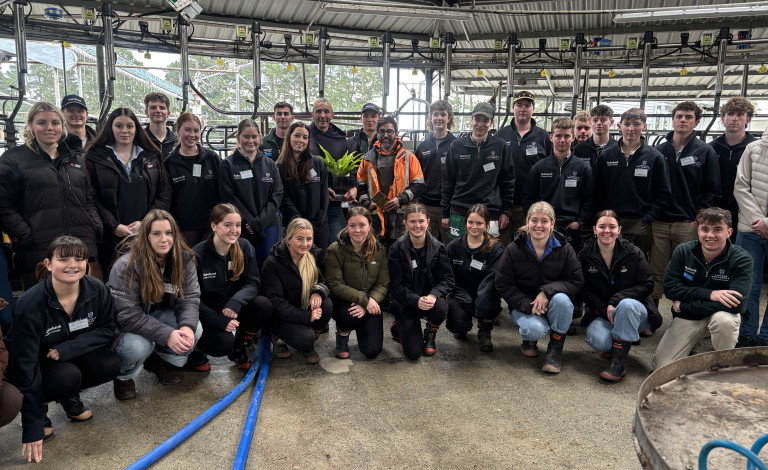Saving lives by rearranging sheep organs: How Lincoln helped revolutionise hormone research
07 July 2025 | News
“If you don’t have these hormones, you’re dead.”
For some people, that’s reality. With modern medicine we know how to treat hormone deficiencies, but the road to understanding was not an easy one. And for Eric Espiner, it began by rearranging the organs on a flock of sheep at Lincoln.
Eric is an endocrinologist and physician who has dedicated his life to understanding how hormones affect the body. Now 91-years-old, he has reflected back on his medical career in his new memoir, A Physician's Journey.
Eric became deeply engrossed in hormone research in the 1960s, when he was deployed as a registrar to the Medical Unit at the Princess Margaret Hospital in Christchurch.
The unit was run by Sir Donald Beaven, who had big ideas about the kind of research they could conduct there. He’d already made contact with researchers at Lincoln University, called Lincoln College by the time Eric arrived.
“I went up to see what my duties would be, and within a minute or two he asked what research I’d like to do,” Eric said.
“He began talking about a new technique which he’d seen done in Melbourne. It was a very fancy surgical technique, they took the adrenal gland from its normal position in a sheep, along with its blood supply intact, and then sewed it into the neck.”
What’s an adrenal gland?
Inside of every person are two small mushroom-shaped glands sitting atop the kidneys. These tiny organs are vital to your health. The hormones they produce regulate your entire body, such as your metabolism, blood pressure, and immune system.
The adrenal gland is hooked up to a small part of your brain called the pituitary gland. This gland tells your adrenal gland how much cortisol to make and when.
These hormones are really important, and it can be seriously bad news if your glands start to fail. The most common cause of adrenal gland failure is Addison’s Disease, which results in chronic fatigue, nausea, dehydration and low blood pressure leading to renal failure. It can be lethal if not cared for with hormone replacement treatments.
But back in the 60s, Eric and the staff at Princess Margaret Hospital didn’t have much to offer in the way of hormone treatments. Diagnosing deficiencies or excesses of these hormones was difficult, and little was known known about how the two glands interacted.
Eric didn’t know what type of research to conduct, so Beaven suggested he work on the collaborative hormone research project with Lincoln College.
“What the research described was just fanciful. I was wanting to run for the door,” Eric said.
“I was ignorant.”
Despite having little experience in the area, Eric ended up as head of the project. Dr Joe Hart in the Department of Animal Science at Lincoln College was delighted by the idea of using sheep to advance medical research and offered a small flock for the research team to use.
The process of moving an organ is not a simple one, and it took many tries before the first successful operation. The team named the ewe Sheba, their golden fleece. She seemed happy and healthy, despite having her glands moved around. Eric described her as “perky.”
But why?
“The point of all this is the ability to take a sample of blood from the adrenal gland at any time. No operation is needed,” Eric said.
“If you were to do that where the adrenal gland lives normally, you’d have to open the animal up under anaesthetic, it would be a one-off kind of procedure.”
Merino sheep have a handle of excess skin on their necks, called a dewlap. This was the perfect new home for the adrenal gland. Moving the organ provided easy and non-invasive access to what was normally a very internal organ. That meant unrestricted access to information on how the organ was behaving and why. They could take samples from it regularly and at any time of the day.
And that’s what they did. Across 18 months the team conducted in-depth research on the hormone levels of a small flock of twelve modified sheep.
Eric remembered times when he would stay up all night with the animals, taking hormone samples every half hour. This provided valuable information into how the gland worked, as cortisol levels spiked at certain times of day.
The opertion also allowed easy access to inject samples into the sheep. They took blood from humans that had hormone diseases, and injected it into the animal. This allowed them to see what was happening between the two glands when hormone levels were too high or low.
The next step was testing solutions on the sheep. Having easy access to hormone measurements meant the researchers could inject new treatments into the sheep, then measure how hormone levels were affected.
So what did they find?
By the end of their research, Eric and his team had a much greater understanding of the relationship between the two glands, the impacts of hormone failure, as well as how to treat it. In the end they had fourteen novel findings to share with the medical community.
Their research was published in the highly regarded UK publication The Journal of Physiology, and helped contribute to major developments in hormone treatments, many of which are used today.
It was also the start of a long and fruitful relationship between Christchurch medical researchers and Lincoln. Our researchers helped develop the understanding of heart failure, skeletal growth, fetal maternal welfare, and the brain itself.
This collaboration continues to this day, and has resulted in hundreds of research publications in leading international science journals.
Interested in learning more about Eric, Lincoln’s medical history and the glands controlling your body? Check out his new book, A Physician's Journey: Chasing hormones you never knew you had, and why you need them.


